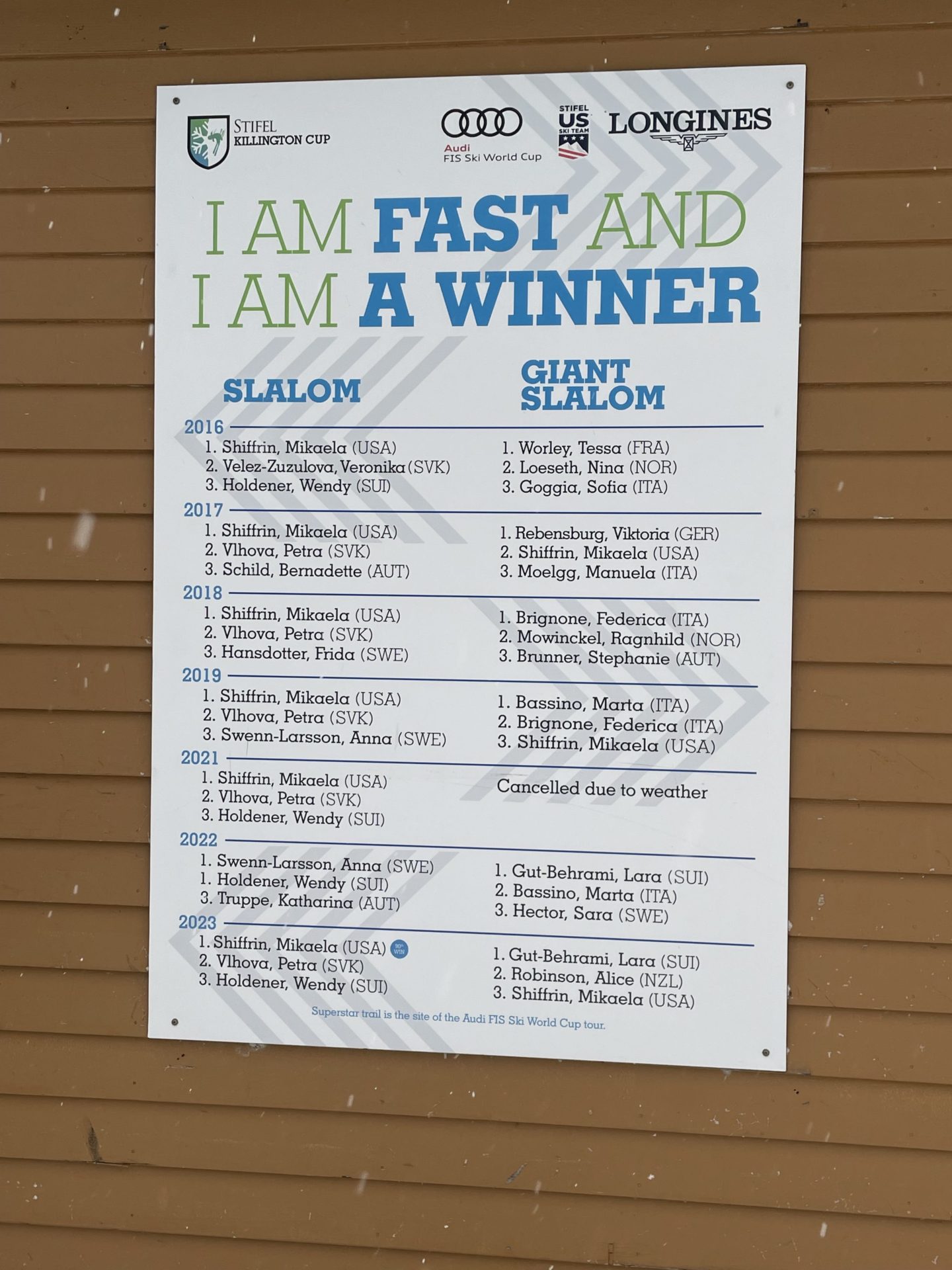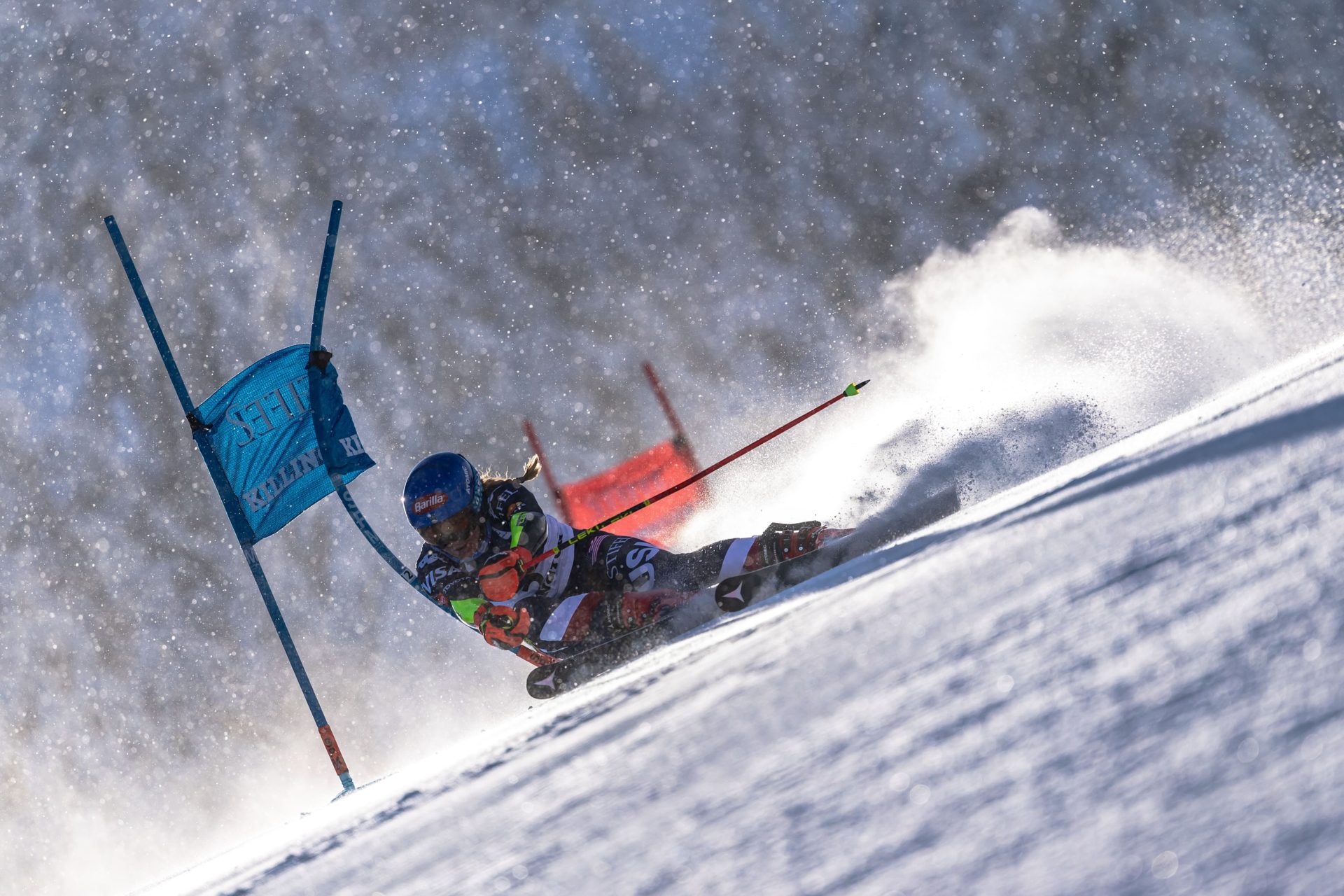
Close to 2 p.m. on a dark, cold, late November afternoon, Mikaela Shiffrin waited in the Start House to take her second run in Killington’s annual International Ski and Snowboard Federation (FIS) World Cup Giant Slalom race. Close to 21,000 people stood, peering up at the hill, stomping the bleachers, clapping, ringing cowbells, and cheering. They had been making noise all day and were getting more excited about the possibility that Shiffrin would win number 100 on home snow. The Killington Giant Slalom has eluded her while she has won the Slalom six times. Taking the Giant Slalom for win 100 would be a nice touch. This was the famous Killington crowd cheering its loudest for America’s champion.
As racers say, the noise would waft up the hill to the start, but it becomes especially loud when they roll over the top of the lower pitch, coming into the full sight of the crowd. Shiffrin has been breaking the World Cup total victory record with every race she wins since she surpassed the great Ingmar Stenmark of Sweden’s mark of 86. 100 is both a new record, but more importantly to the public’s imagination, a big round number. When Shiffrin won the Slalom in Gurgl earlier in November, it set up the scenario that American ski racing fans were crossing their fingers for: she would be able to reach the milestone on home snow at Killington. It would not be easy. Though Shiffrin had the fastest time in run one, other great skiers were lurking, most notably Sara Hector, the Olympic Gold Medalist from Sweden.
The run-up to this moment started the night of November 14, when Killington would ramp up its modernized snowmaking system. Superstar has 92 hydrants plus five fan guns mounted on towers at the bottom of the trail. The guns ran non-stop for nearly three days, covering the entire trail. Disaster struck when the region suffered a sustained run of warm weather over 32 degrees. Still, the snow on the Superstar was able to withstand the heat shock. Locals were nervous; two days before FIS snow control, snow cats began working the hill and spreading the snow. Killington has five snow cats equipped with special equipment that enables the driver to track snow depth. Using this technology, the snow was distributed evenly over the racing portion of the trail. Would there be enough snow? Probably not. The event hung in the balance. However, Killington’s stellar reputation with the FIS for high quality and quantity snowmaking combined with the forecast for cold weather (and even snow) was enough for the decision to be made: board the planes and ship the gear. Killington 2024 was a go.
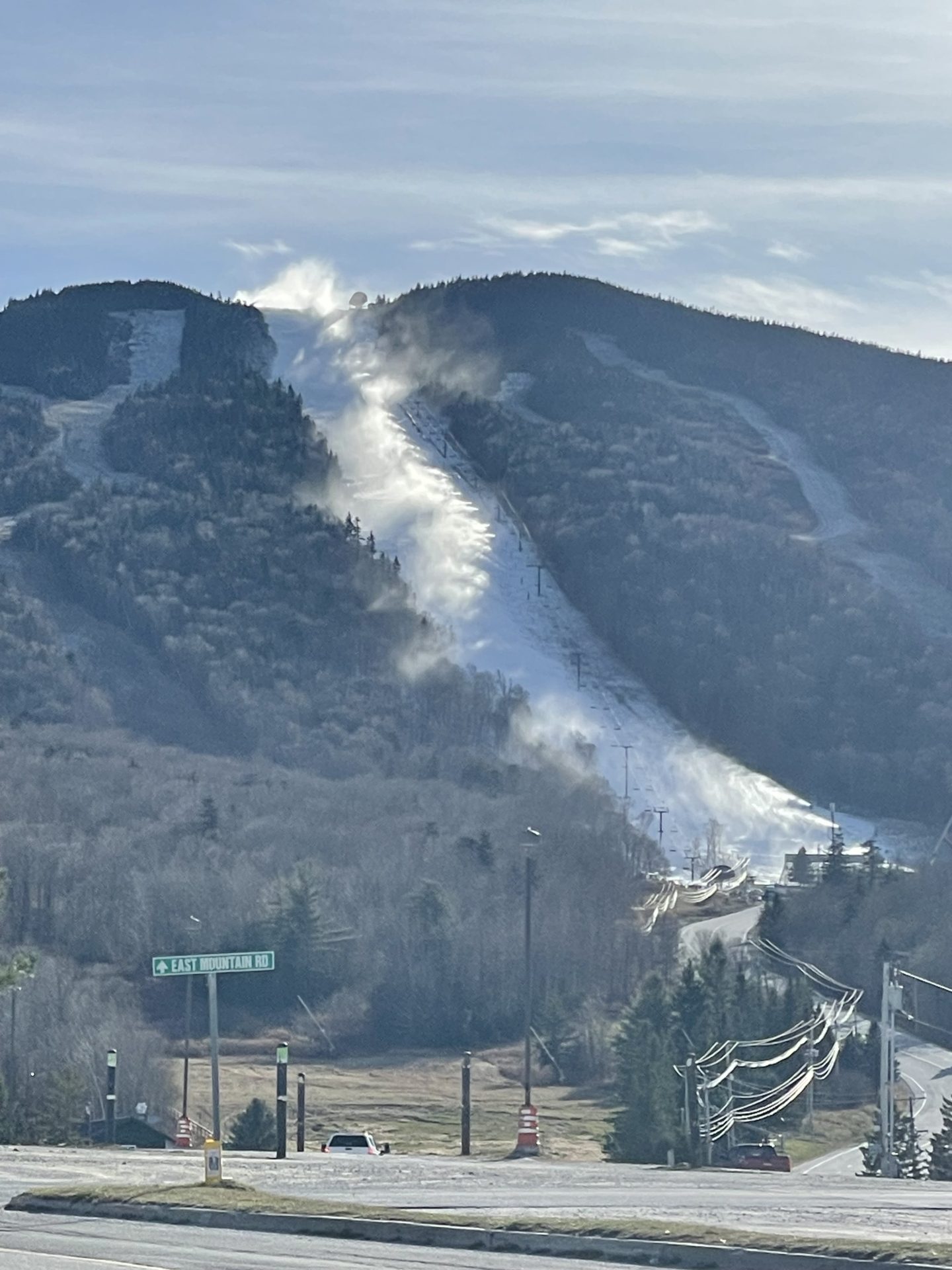
The mid-November snowmaking date was a good seven years after the original start for getting a World Cup race at Killington. In an interview the week of the race, Mike Solimano, President and CEO of Killington and Pico Resorts, told SnowBrains that the entire event was the brainchild of Powdr’s Herwig Demschar: “Back in the day, he worked at Powdr in different roles; he was a ski coach for a long time,” Solimano said. “He was Picabo Street’s coach when she won gold. He was the one who had the idea and spoke with John Cumming (Powdr CEO) about doing a World Cup. It’s all from him and his contacts, that is how it got started.”
Herwig Demschar has had an illustrious career in the ski industry that includes coaching stints with the Austrian and American Ski Teams and working on the Salt Lake City, Torino, and Vancouver Olympics before heading to Powdr corporation as a Vice-President for Venue Management and Event Services. Talking with SnowBrains before this year’s race, Demschar remembers: “I started to work for Powdr in 2007 and I remember when I came to Killington for the first time. I saw Superstar, I mean like, wow, you know, that would be a cool hill for the World Cup. Along with the trail, there are many reasons for this site: easy access by the roads to the whole infrastructure, including the cabling for television, the Grand Hotel for housing the athletes and coaching staff, and the arena for the spectators. It was kind of a one-stop deal.” Demschar knew that racing would be popular in the East; he had coached at the last American World Cup races held in Waterville Valley in 1991.
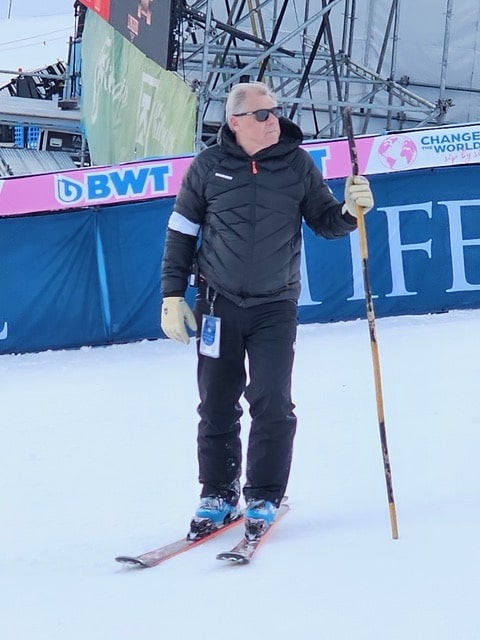
As Demschar recounts, the actual races that exist now were not what he originally envisioned. Demschar planned to use the Boston Ski Show to highlight ski racing by hosting a Women’s FIS Dual Slalom event at Fenway Park in Boston. Snowmakers from Killington would prepare the track; the race would be on Thursday and then the racers would go to Killington to free ski on Friday. The idea was too complicated;t here was not enough room in the stadium to create a scaffold high enough to support a ski race and the event morphed into Big Air, which was held on February 11, 2016. Demschar returned to the idea of staging a World Cup race in the East. He recounts, “I knew the biggest membership of ski academies was in the East, along with the biggest buyers for soft and hard goods.” He remained determined to stage a World Cup Race in the East. “The main philosophy behind the event was to expose kids and parents to the best female skiers in the world,” Demschar said. “Hence, we have this parade for the race programs and we have over 900 young racers march every year. It can only be appreciated when you see it live.”
It was important for the event to have as many spectators as possible and to show the world that racing could draw a large crowd in North America. Races in Lake Louise and Beaver Creek have small crowds. “Let’s make it a North American ski race with a little bit of European touch in that we have a lot of people in there celebrating the sport, and this would set us apart from the rest of the ski areas in the East, that we are the Beast of the East,” Demschar said. Drawing large numbers has not been a problem; in the first year, Demschar planned for approximately 5,000 people to show up each day; the event drew 10,000-12,000 per day. According to Killington, the 2024 race series drew: 7,500 for the Friday Bib Draw; 21,500 on Saturday (a single-day record); 10,000 on Sunday; and a total of 39,000 overall.
The FIS was hesitant to race in the East as it didn’t trust the Resort’s snowmaking capacity. Lobbying the FIS to take the chance was one concern, finding a slot on the calendar to schedule it was another. Superstar sits in the middle of Killington and it isn’t possible to close it to the public when the season is in full swing. For a number of years, Aspen hosted Women’s World Cup races over Thanksgiving weekend, but they decided to apply to host a World Cup Finals. To be considered, they would have to give up their November races. They did and Killington was approved by the FIS for races in 2016. The inaugural races were successful and now the FIS wants to race at Killington.
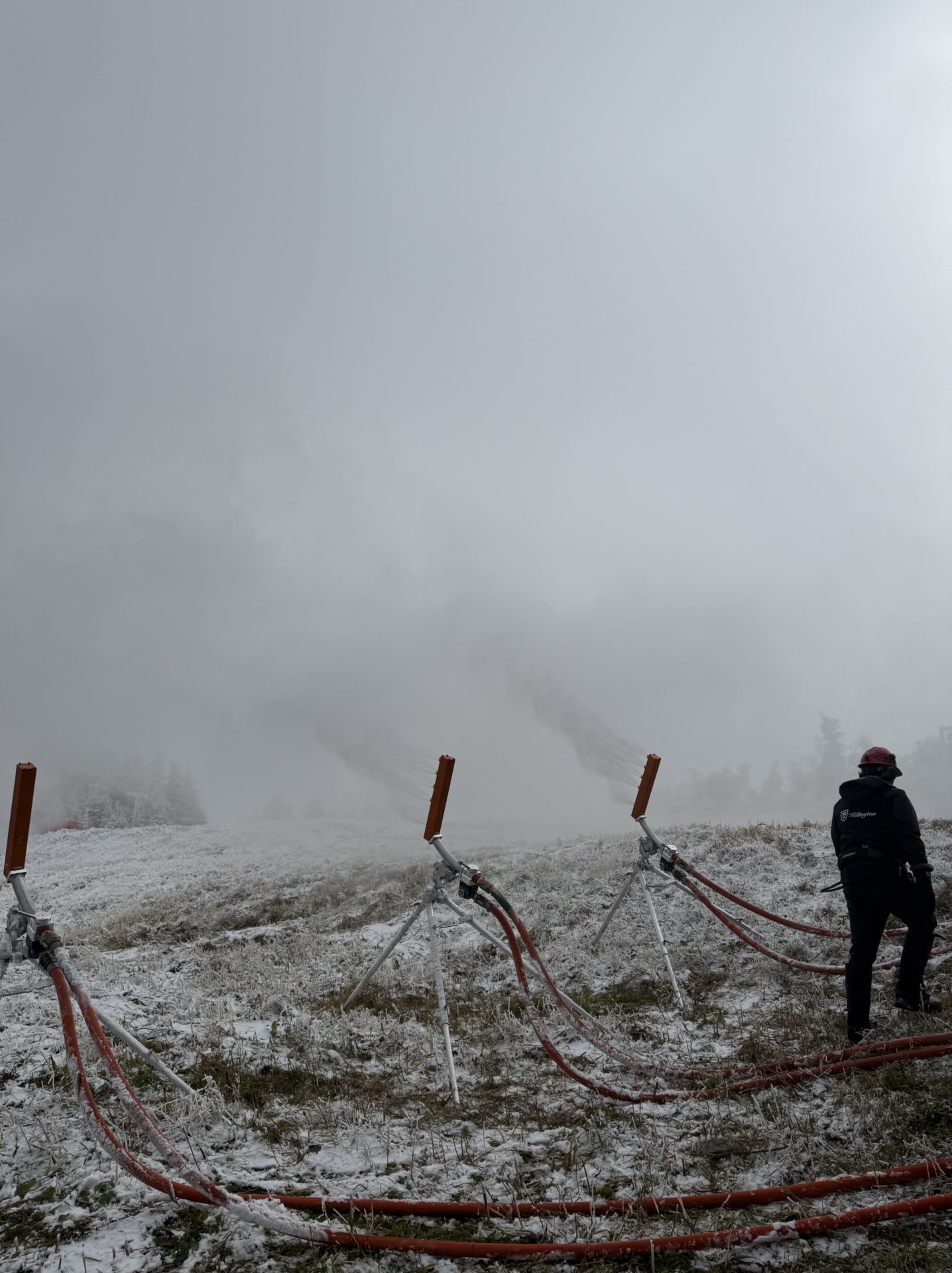
Long before racers can get out on the hill to race, a significant amount of work is required. Organizing and running a World Cup Race is a massive event requiring over 300 volunteers, multiple departments from Killington, and complex logistics. The Local Organizing Group (LOG), chaired by Demschar, works together with the Resort to set up and run the race.
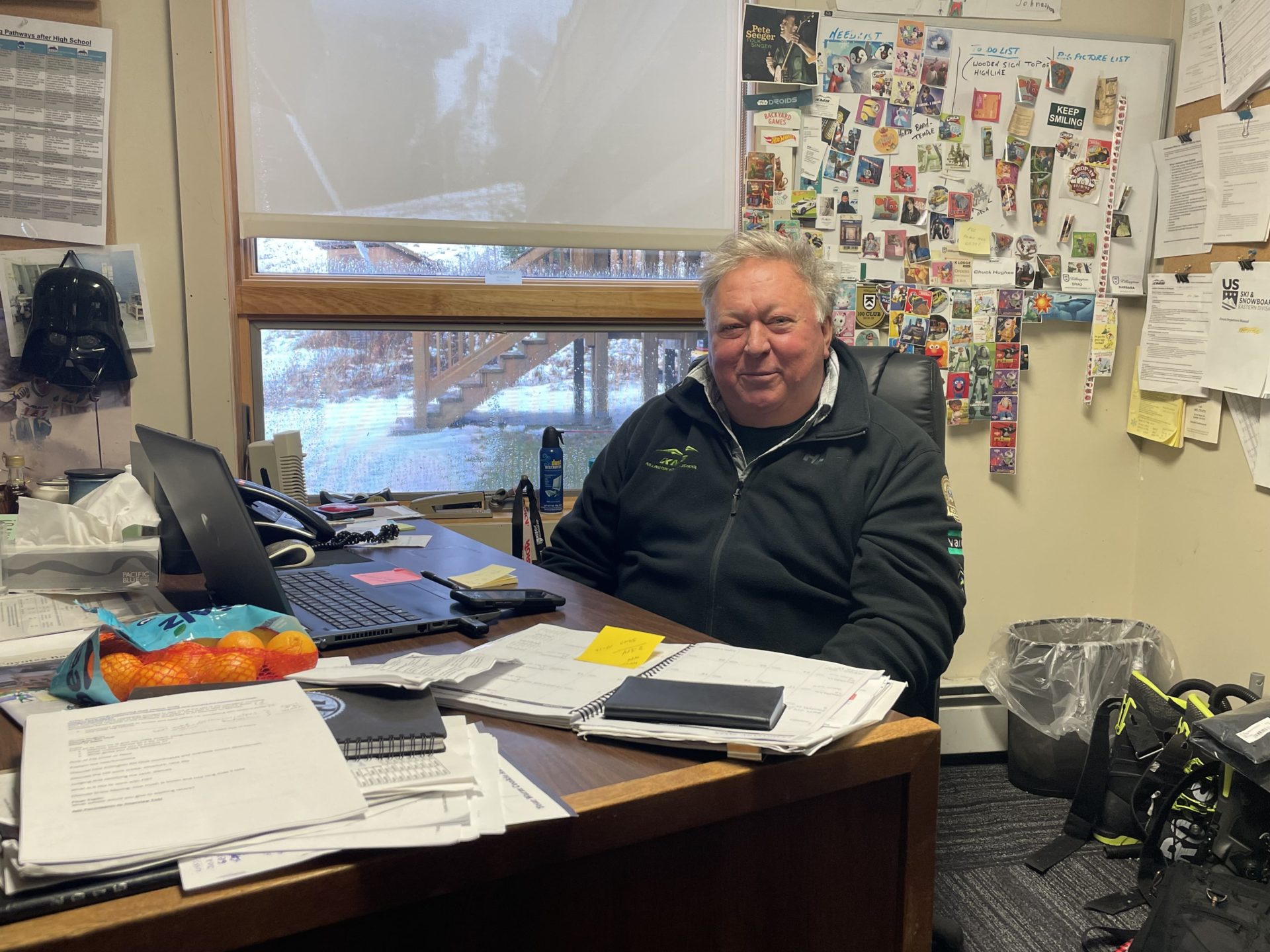
The Superstar trail surface must be prepared to FIS specifications and the race must be adjudicated. This is where Chuck Hughes, FIS Chief of Race, steps into the picture. Hughes is a long-time Vermont USSA coach, Alpine Official, FIS Technical Delegate (TD), and a recent inductee into the Vermont Alpine Racing Association (VARA) Hall of Fame. He oversees all aspects of race preparation and certification. “Right after we finish the race, we start next year’s planning and thinking and working on the things that went well and on the things that didn’t go well, trying to pay attention to how we can make things better,” Hughes said. “We’ve done a pretty good job; we try not to change much.”
Work Teams organize to build the race piste. They must coordinate with other departments and external entities to ensure that the Resort is prepared: aspects include meeting with snowmaking, grooming, the Local Organizing Committee, and the technical advisor from U.S. Ski and Snowboard.
| Team | Function |
| Air Fence | Responsible for setting up all air fences and their daily inspection to ensure safety. |
| Banner Crew | Responsible for placing all advertisements on the course. |
| Dye-Crew | Responsible for applying dye to the Giant Slalom course. |
| Gate Judges/Keepers | Responsible for monitoring athletes while racing and for fixing any damaged gates and/or race surface. |
| Race Administration | Responsible for Coaches’ Meetings, FIS official paperwork, Bib Draws, and Bib Seedings. |
| Slip Team | Responsible for slipping the hill to prepare it for racing and slipping the course on the day of the race to keep it smooth. |
| Timing | Responsible for the primary, back-up, and athlete sensor timing systems. |
Hughes is especially grateful for Killington’s snowcat drivers. Their work is critical for preparing the hill. “We’ve got some outstanding cat drivers here at Killington. Great group of guys to work with,” Hughes said. “We’ve been lucky because the team has stayed the same for eight years now.” It takes a lot of specialized people with extensive ski racing experience to prepare and stage the race; they come from Vermont, New Hampshire, Maine, New York, and Canada.
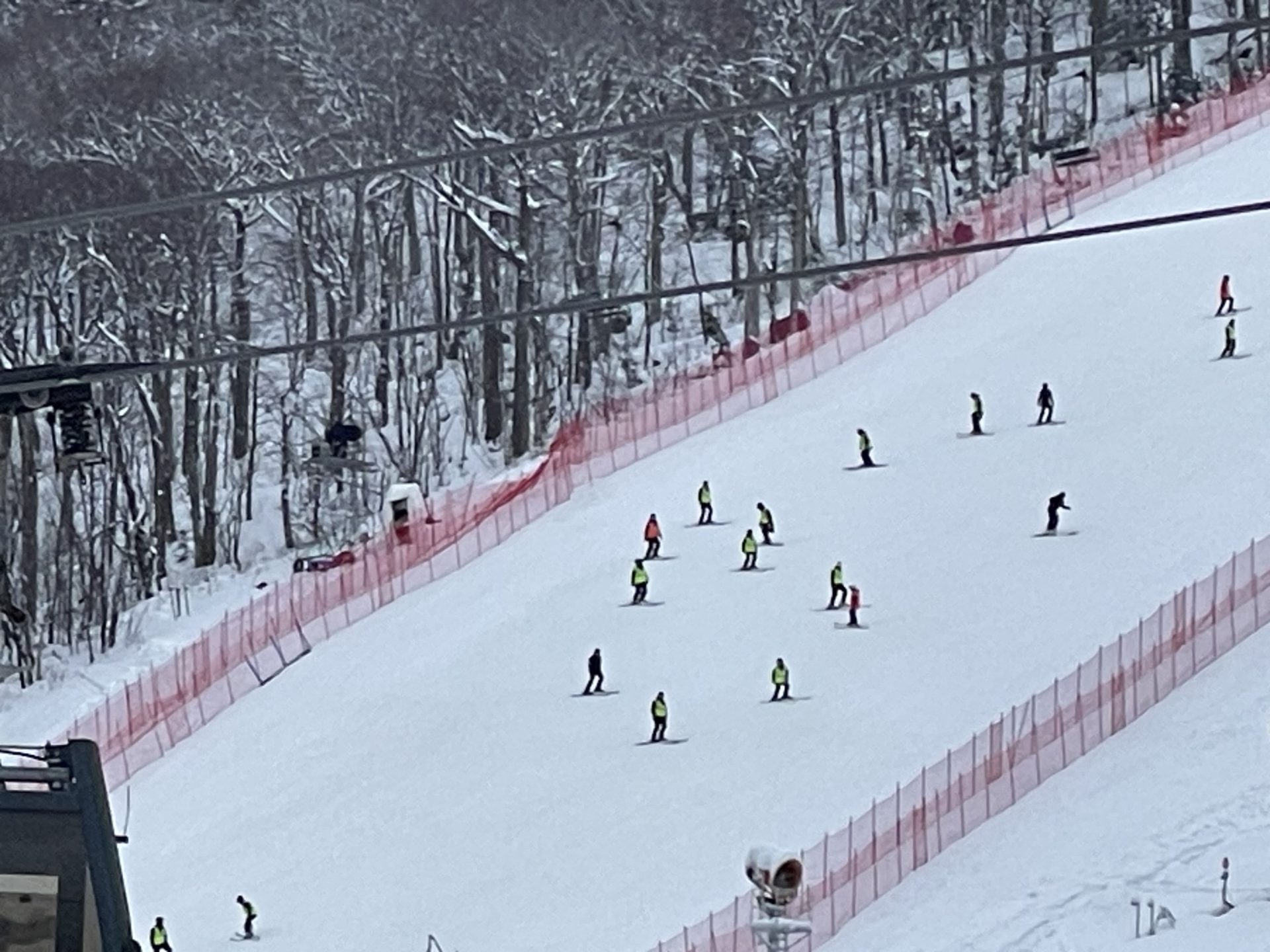
Turning a ski slope into a race hill is a methodical procedure that requires many skiers to constantly side-slip the surface repeatedly. This has the effect of compacting and “polishing” the snow with the surface getting progressively firmer. Tyler Smith, Killington’s Chief of Course, is in charge of preparing the race piste; he directs the slip crew, which is organized by Sean Graves, a 30-year coach. Graves manages 30 skiers and they do whatever needs to be done. Along with slipping the trail before and during the race, the crew also brings rolls of the B netting (safety fencing) down to their right spots, and they set up the pipe connections for watering the race course. The crew had a fireman who was good with dealing with the pipes and some young racers from local academies who would go off the piste into waist-deep snow to connect them. After slipping and setting up the Superstar, they watered it down on Friday night to prepare for the weekend of racing. Spraying or injecting a course is done to freeze the piste so it will stay hard for all the racers.
The surface for the two races was rock-hard Eastern racing snow. This was evident Saturday morning when the racers queued up for a structured free ski on Superstar at 7:00. In previous years, Killington would prepare the Skye Lark for training. FIS rules close a race trail before a race so no one can train on it and have an unfair advantage for race day. However, none of the athletes had the opportunity to ski or train on that side of the mountain yet. One by one, the racers were released out of the start gate at the top in timed intervals. Each racer had space from the others so they could ski and inspect the trail. It was clear from watching the racers on the lower pitch that the snow was hard and would hold up for the racing. Each athlete was carving full Giant Slalom turns as they rocketed down the pitch at 50 miles per hour. After their one training run, several racers were seen boarding the K-1 Gondola at approximately 8:30 to get a quiet top-to-bottom training run before the mountain opened up to the general public: these included New Zealand’s Alice Robison and Croatia’s Zrinka Ljutić as well as racers from Italy and other National teams. Afterward, the racers agreed that the track was well-prepared and fair; each day, the races had successful back-of-the-pack attacks in the first run. The trail was used for an additional three days of training after the weekend as several teams stayed to train at Killington due to the cancelation of Mt. Tremblant’s two Giant Slalom races.
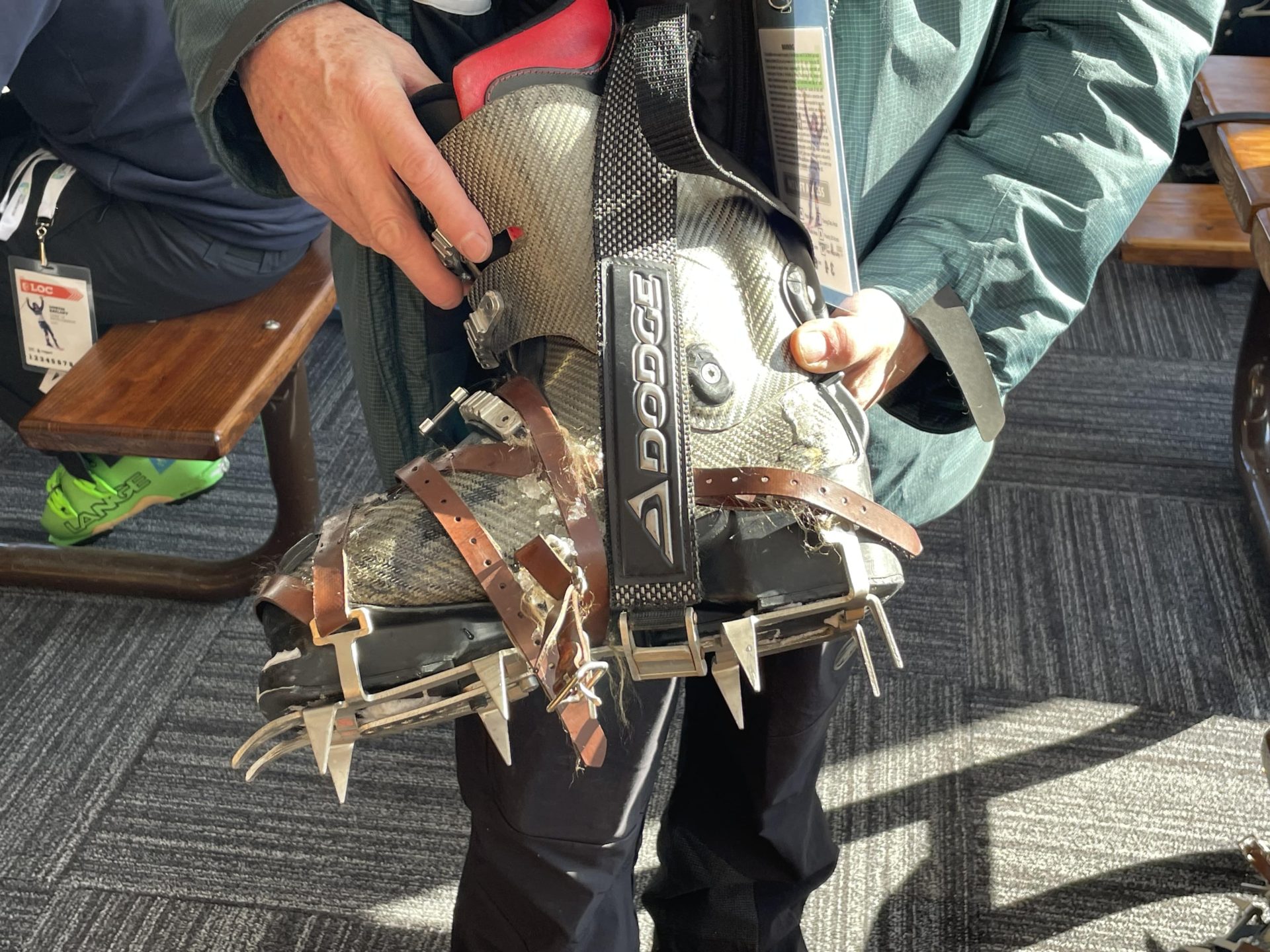
On Friday afternoon, the Stifel U.S. Ski Team held its annual Killington Athletes Press Conference. The Women’s Giant Slalom squad was coming off a successful early season performance at Sölden where Hensien (4), Shiffrin (5), O’Brien (7), and Moltzan (11) placed in the top 11. Expectations and hopes were high. Returning from injury, Nina O’Brien, seventh in Sölden, commented: “The injury is the last thing on my mind. I have confidence that my best skiing can stack up with the best in the world.” When asked about racing at Killington, Nina responded, “I like the track; it looks simpler than it is. It’s pretty intense. Coming over the last pitch and seeing the crowd, there is nothing like that on tour.” Katie Hensien, commenting on the early season Austrian Giant Slalom, said, “The result proves that I belong up there.” For Saturday’s race, Hensien said she would “have fun, enjoy the day, and ski fast.” Paula Moltzan has been successful at Killington in the past. When asked which event she was most looking forward to, she replied that it was Slalom. “The last bit of the Slalom is really steep and that is in my favor,” Moltzan said. “I like the steeps more than the flats.”
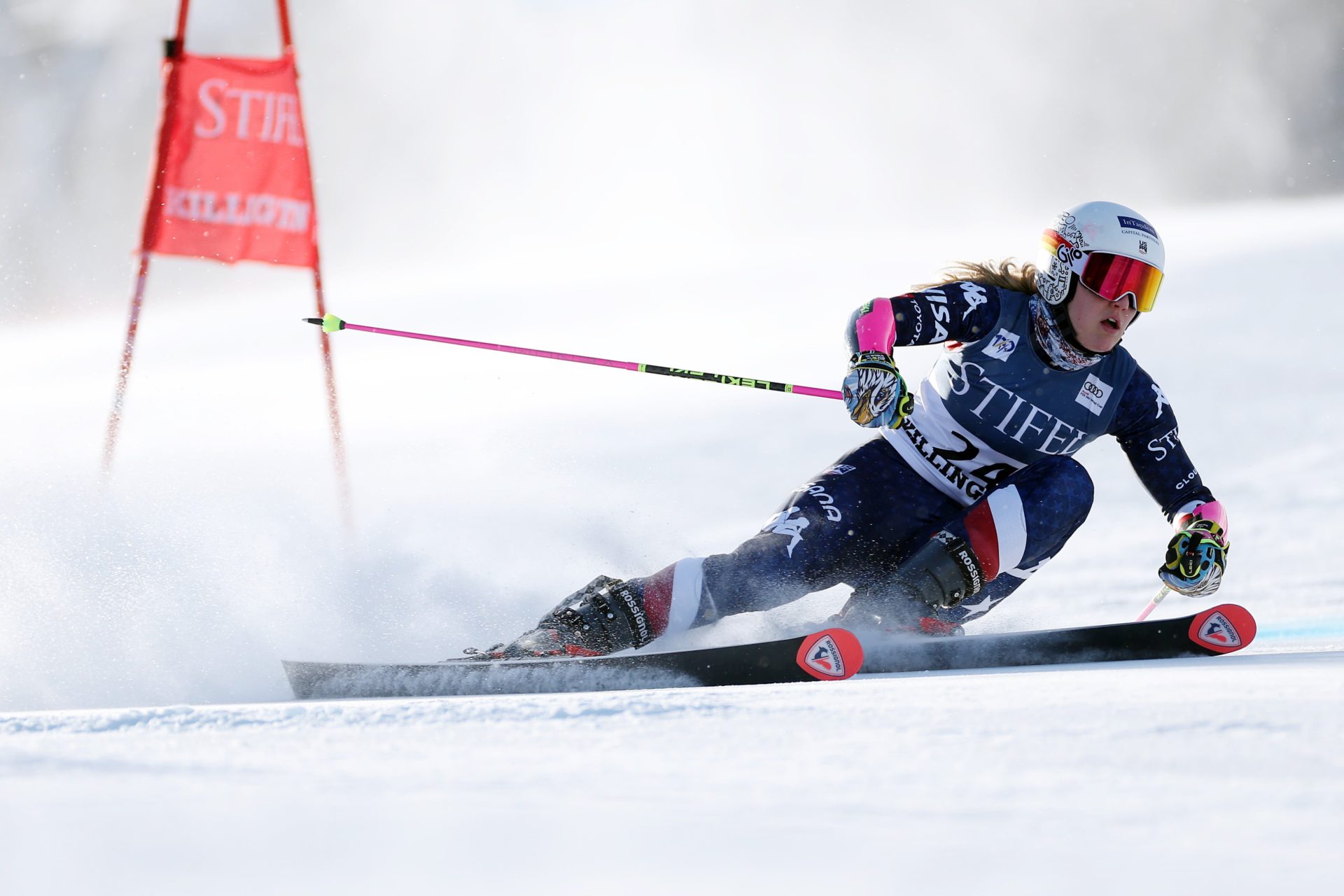
Moltzan told the crowd that she is a Vermonter by choice now that she has moved to the State. “I make a big effort to partner with Vermont companies,” she said. When asked if it was true that there was a beer named for her, Moltzan said yes, and that if she wins a race, she’ll chug it on the podium. When asked about Killington, the new Vermonter replied, “The crowd is unreal. This is my favorite race of the season. I would love to race here for the rest of my career.”
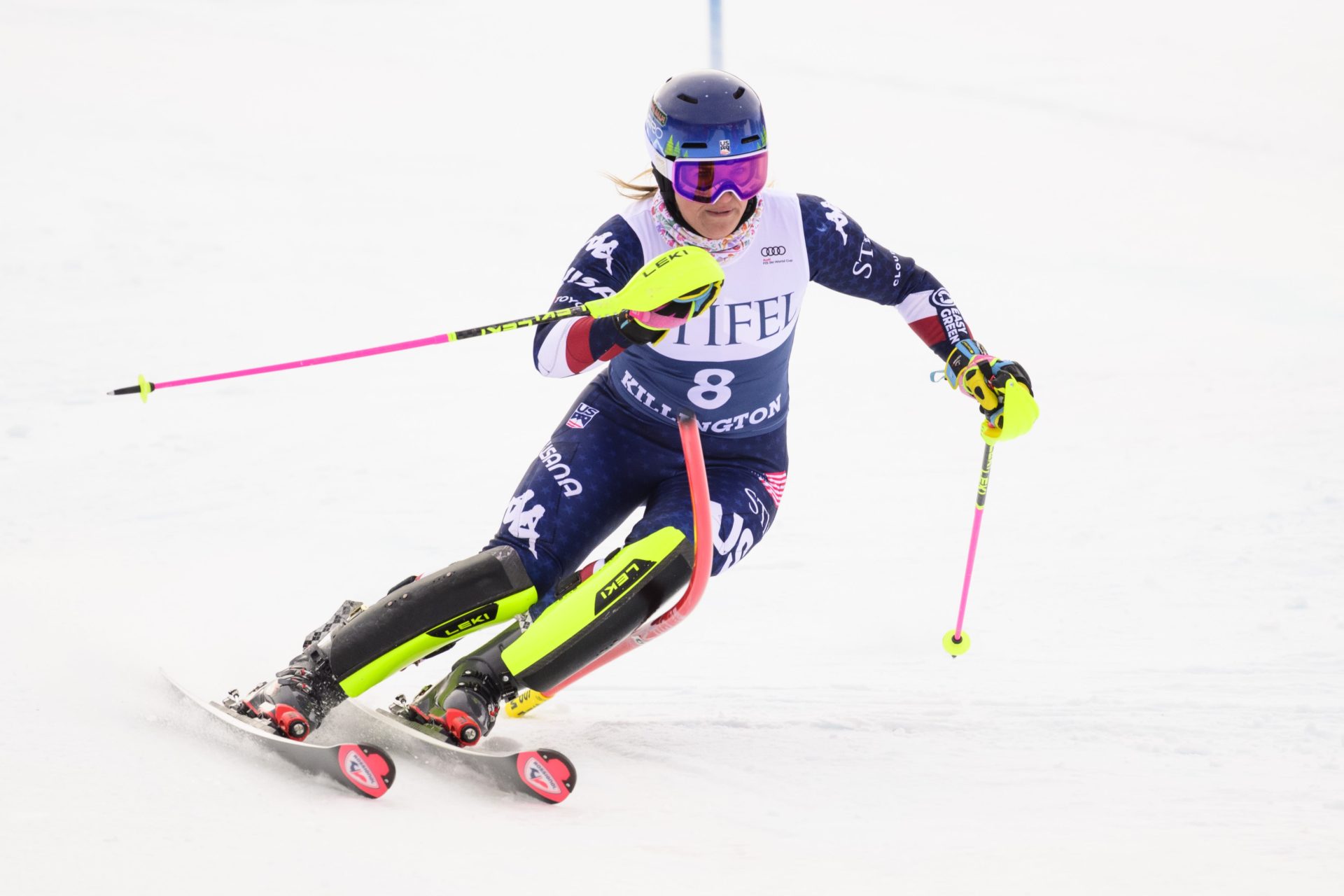
Up-and-coming skier Elizabeth Bocock said that she was still young and a rookie. “I’m learning from other racers how to leap from NOR AM success to World Cup,” Bocock said. Bocock is learning quickly: she raced from 47th to 8th on the first run: a stunning back-of-the-pack attack. She would falter in her second run to finish 23rd overall, but she skied aggressively and will be back. Mia Hunt, an independent racer from the University of Denver, would be making her first start in Slalom having qualified through a time trial, a path that was also traveled by Paula Moltzan. Hunt told the assembled journalists, “I’m super excited. Looking forward to seeing the scene. This is the first time I’m racing the best people in the world.”
Hovering over everyone was the knowledge that Shiffrin would be going for win 100. That creates its own frenzy with Paula Moltzan saying it would be “great to witness it, especially at home.” At the same time, these athletes are there to race and win; they are still Shiffrin’s competition.
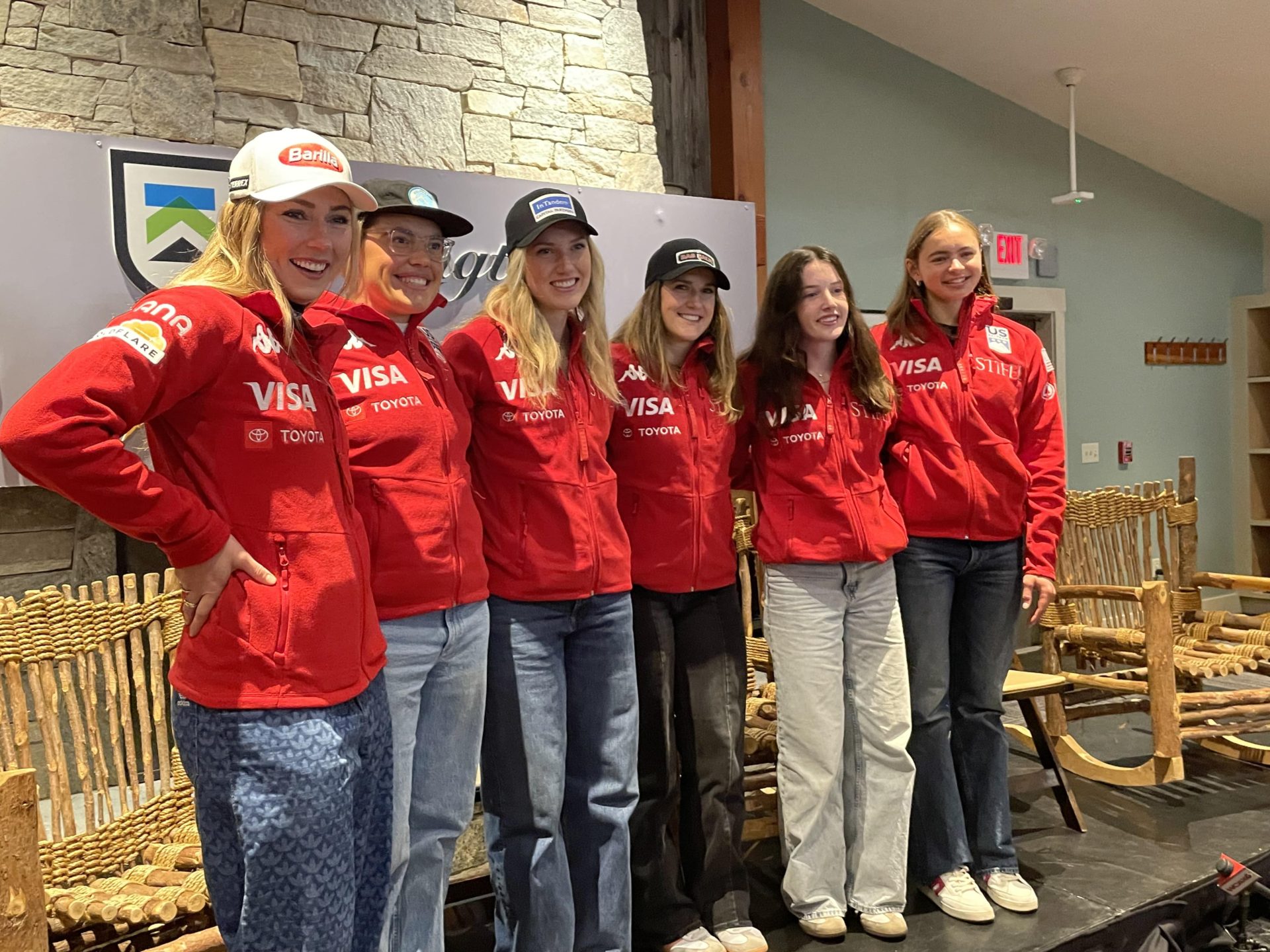
With the Press Conference obligation out of the way, it was time for the Bib Draw. The Friday night Bib Draw is a big tradition on the World Cup; it brings the top 15 athletes to introduce them to the public and venues usually host a large party. This is Killington, so hosting a large party is no problem. 7,500 fans were on hand to watch the top 15 racers get past Doug Lewis’s annual activity (nerf axe throwing) to draw their starting bib number. The show is fun for the crowd with a large fireworks show and DJ.
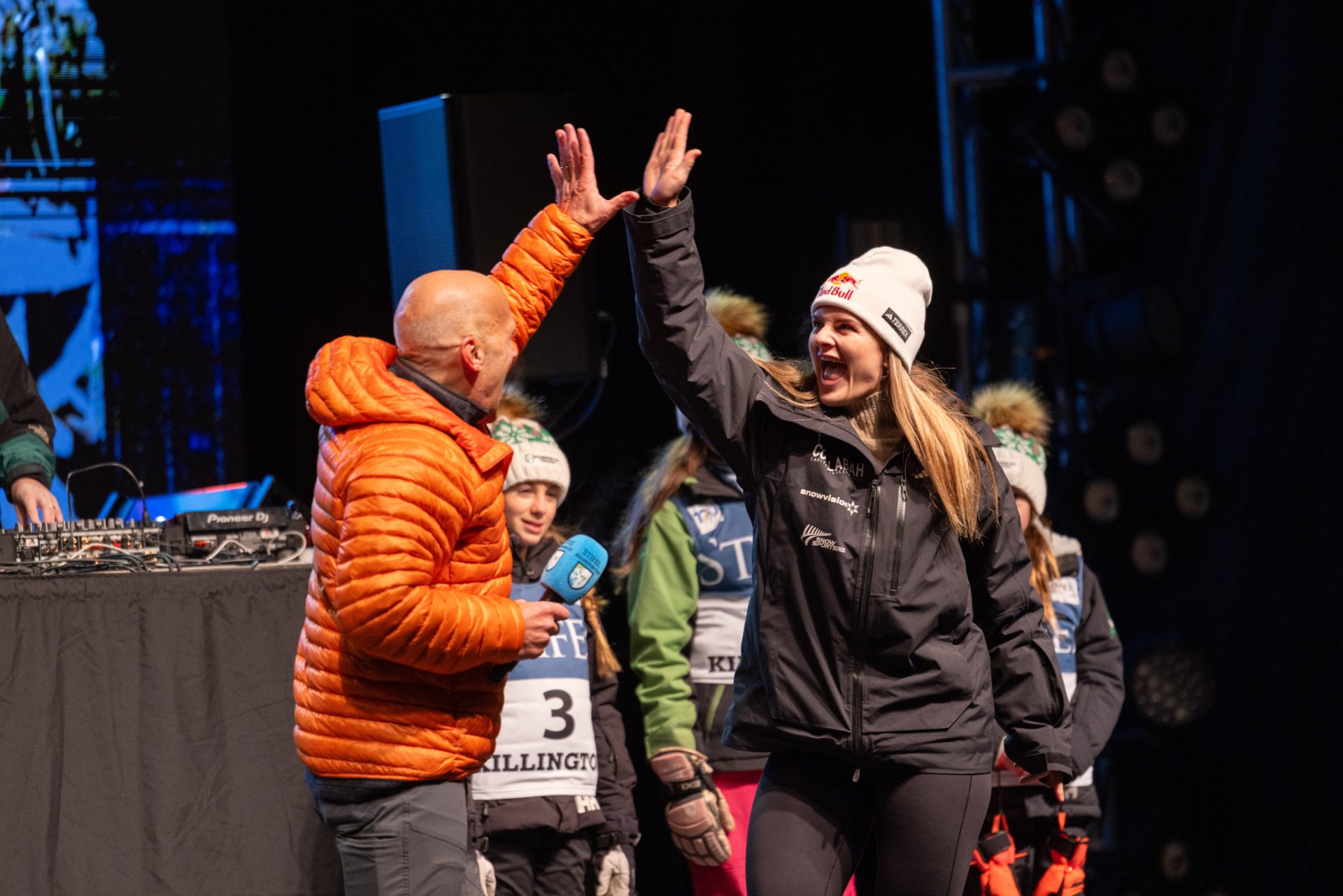
The Superstar Race Trail
| FIS Technical Data | Description |
| Course Name | Superstar |
| Start Altitude | 1066m |
| Finish Altitude | 782m |
| Vertical Drop | 284m |
| Homologation Number | 11885/12/15 |
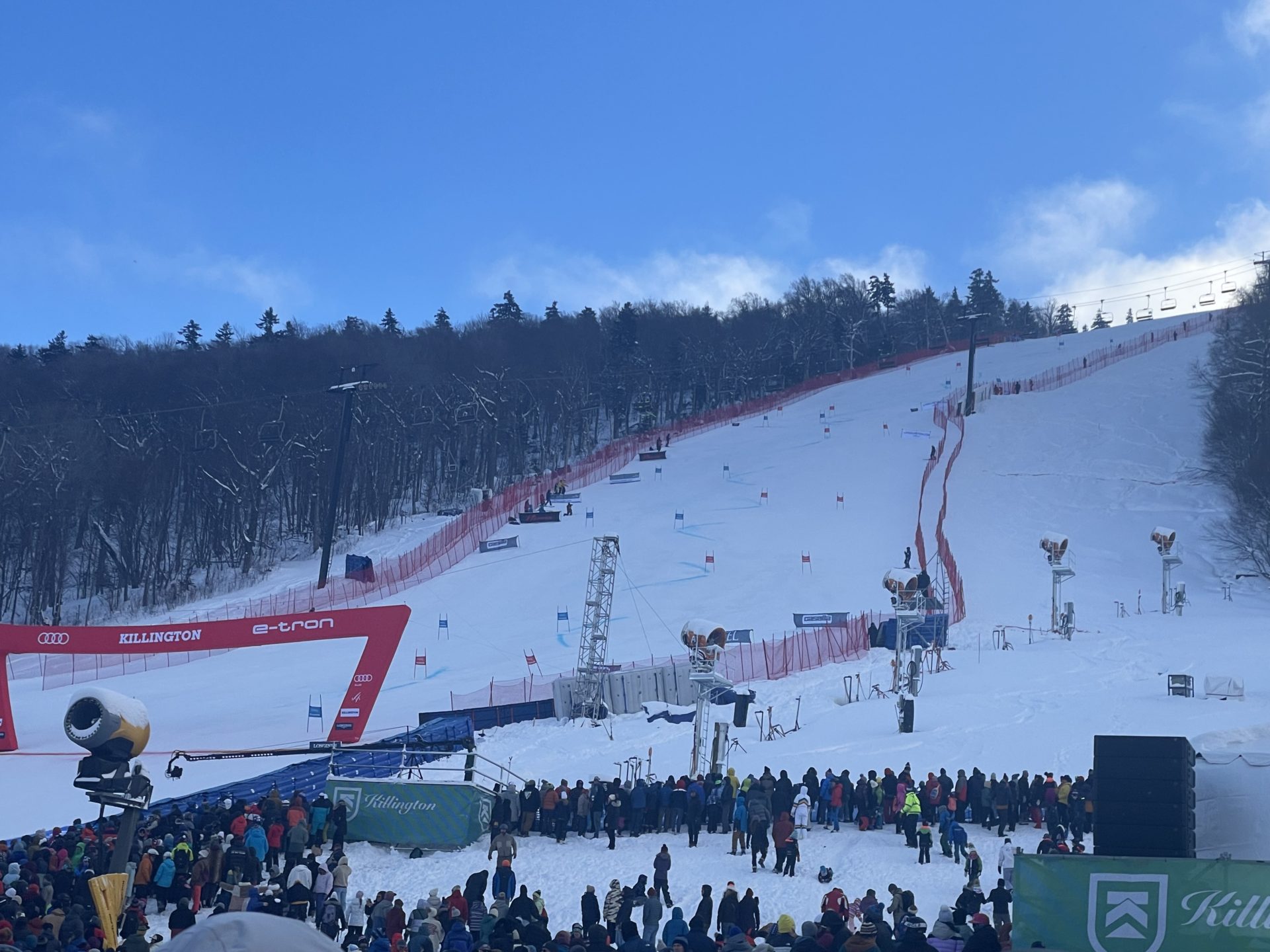
Before becoming a favorite of ski racers on the World Cup, the Superstar was popular with many skiers who love to ski deep into the spring each year. From November until early March, the Superstar sits in the dark, rarely seeing any sunlight. In the mid-winter months, some light will shine on the middle of the trail late morning, but the upper and lower headwalls sit in darkness, staying cold and holding their snow. The trail is steep (32-35 degrees) and challenging with rollers, side hills, and other terrain.
Superstar is approved for the two technical alpine disciplines: Giant Slalom and Slalom which require racers to navigate tight turns and in Slalom, complex gate sequences. On Giant Slalom courses, vertical distances between gates on the World Cup range from 24-28 meters with 10-12 meters of offset, according to the FIS. On Slalom courses, vertical distances between gates on the World Cup range from 9-11 meters with variable offset, according to FIS. Slalom courses are more arhythmic, with multiple combinations (delay, hairpin, and flush); offset varies and is narrower than Giant Slalom. A racer’s ski tips and boots must pass through each “gate,” breaking the imaginary line between the turning and outside pole. If they fail to do so, they are disqualified.
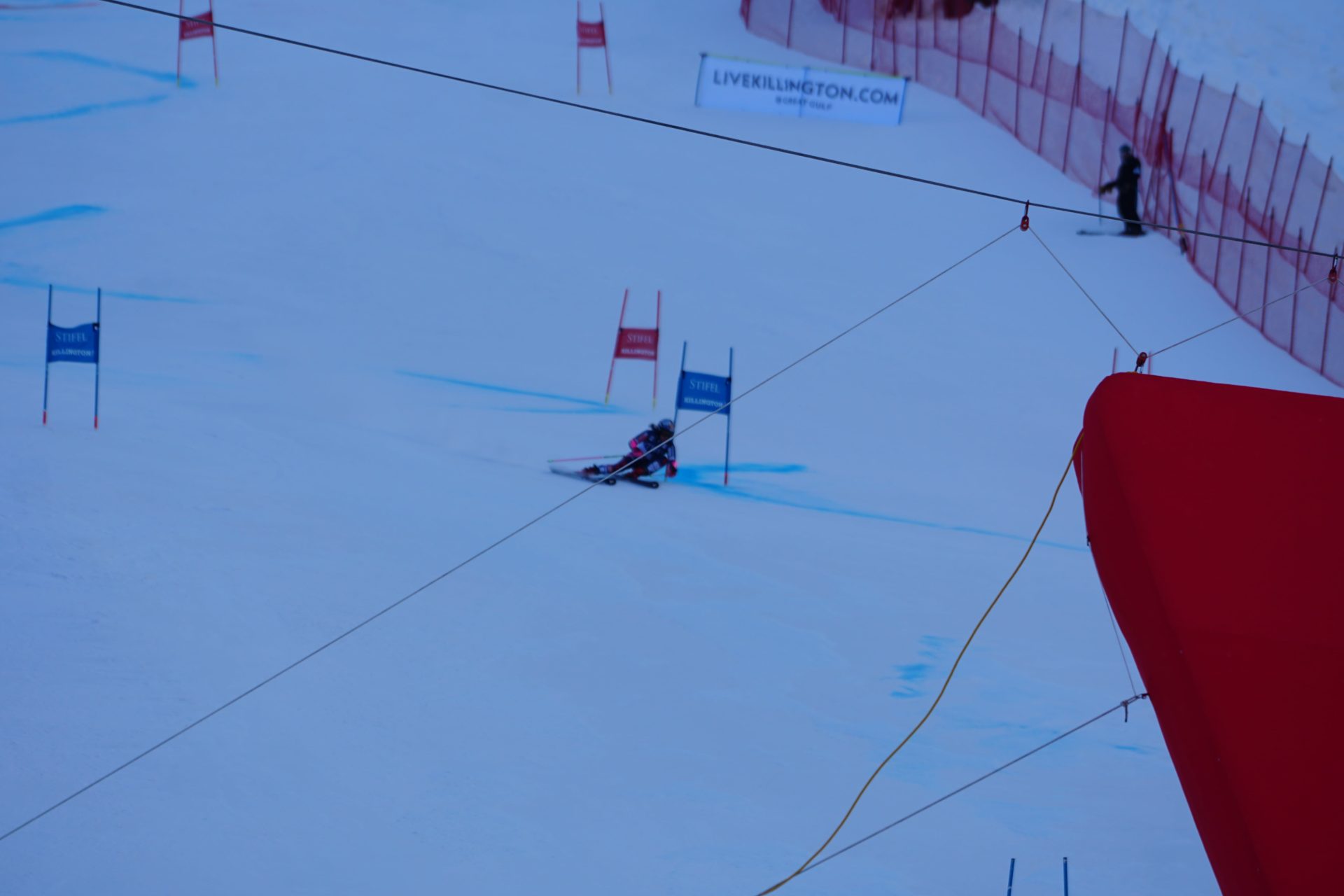
The trail has three major sections: the Upper Headwall which is a steep section from the top to the intersection with Launch Pad; the Fields (Upper and Lower), an inclined flat section that runs from the Launch Pad to High Road; and the Lower Headwall (Preston’s Pitch) is the steep bottom section that ends with the finish line. The Giant Slalom is run from the top of the trail and the Slalom starts just below the Launch Pad. Both Giant Slalom runs had 41 total gates with 39 turning gates per course (two delays). Slalom run one had 64 total gates with 63 turning gates (one delay) and the Slalom run two had 64 total gates with 63 turning gates (one delay). Regarding the trail, Demschar stated, “It’s a classic hill, it’s the whole event that has become a classic on the tour.” Greg Petrics, a former NOR Am and National Championships level racer and co-founder of the Famous Internet Skiers, grew up racing in the Pico and Killington Ski Clubs. He confirms that this is a tough race trail. Discussing the merits of the course, Petrics said, “It is a challenge. You stand on top of the trail and it will fall out from under the racer right at the start of the GS. The hill has a subtle double fall line in the middle that sneaks up on the racers. The middle pitch is trickier than one might think and the Lower Headwall is really steep. It’s easy to fall on this trail, and that was seen in the first run DNFs. It faces north and it’s cold and dark, which is good for the snow.” Both Demschar and Petrics agree that for Giant Slalom it is a bit short, with race times clocking in at under one minute.
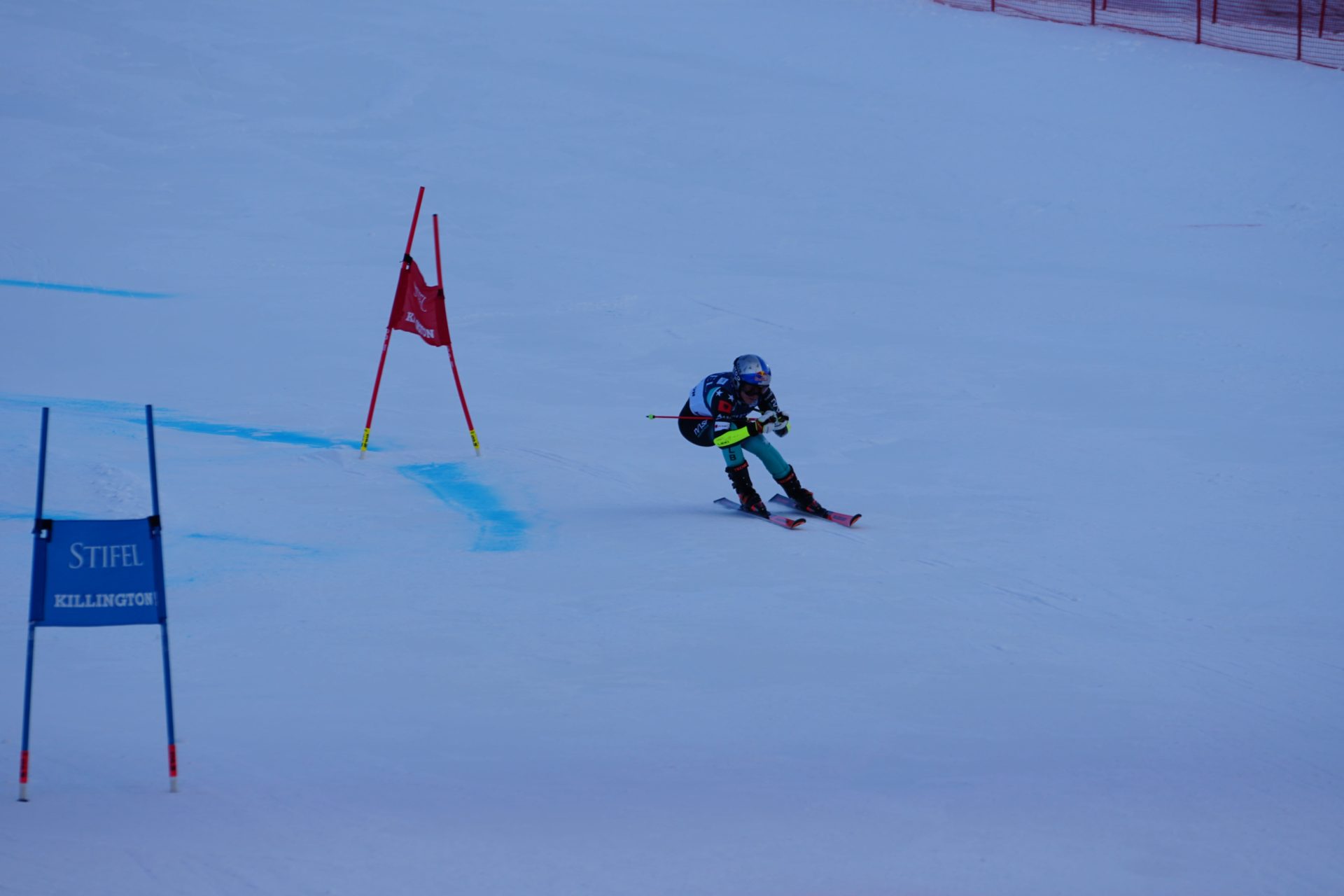
Hosting a World Cup requires extensive snow-making capabilities. The resort has invested significantly in its snowmaking capabilities and is now covered with new HKD high-efficiency snow guns along with five snow cannons at the bottom mounted on towers. Building a World Cup race piste in November in the East is not easy. This year’s Fall was temperate and after a burst of snowmaking weather, the temperatures stayed warm. According to Demschar, if this were another hill, the race probably would have been canceled, but “[the FIS] doesn’t trust the snowmaking team, and they trust whoever is involved from the resort.” There was a period of cold weather that would enable Killington to finish the snowmaking.
On Saturday, Mt. Tremblant did not pass Snow Control and its races would have to be canceled. It was rumored that the FIS contacted Killington to see if it could host an additional race on Monday. When asked for comment, Amy Laramie, Vice-President of Brand Marketing and Events at Killington, confirmed that this was true and wrote: “FIS, Killington, and U.S. Ski & Snowboard evaluated the situation, but logistically it was not possible. The resort was honored we were even approached and it showed a true testament to our snowmaking capabilities that we were asked to host a Canadian race.” With the snow made, the racing piste constructed, the television cameras set, and the Bib Draw completed, it was time to go racing.
One last racer was still left waiting in the starting gate in Saturday’s Giant Slalom. Experienced racers have strategies for dealing with the challenges of the two-run technical race format and Shiffrin is known as a master of routine. She will even nap between runs. When asked what sets Shiffrin apart from her peers, Demschar said, “I think she separates herself from the way she mentally approaches the whole thing.” Ten seconds, five seconds, then the starting clock beeps down the last five seconds and Shiffrin exploded from the start and onto the course: six steep turns down the Upper Headwall and onto the rolling terrain of the Fields. The racer must control their aggression but still ski fast. Unlike the first run, the course would not be as clean as if she ran early in the start order, but credit must be given to Chief of Course Tyler Smith and all the volunteers and mountain operations employees who built and maintained the race piste. The athletes said it was a firm and fair surface for everyone. Breaking over the final drop, the roar of the crowd in her ears, Shiffrin was a couple of turns into the steepest part of the course when she put a pinch too much weight on her inside ski and pitched forward. The combined effect of the two small bobbles resulted in her somersaulting across the hill at 50 miles per hour and slamming into the red B safety netting that lines the course from top to bottom. Somehow in the melee, she suffered a puncture wound to her abdomen. 21,000 voices and cowbells were silenced immediately. The crowd stood, staring up at the hill. The fall happened so quickly that the majority of fans were trying to piece together what had happened. All they knew was that the seemingly certain 100th victory was snatched away in a hundredth of a second. There was a collective sense of shock.
Sara Hector of Sweden, Olympic Gold Medalist and World Cup race winner, won the race. Zrinka Ljutić, the up-and-coming star from Croatia, earned her first World Cup Giant Slalom podium, finishing second, and Camille Rast, another young star from Switzerland, rounded out the podium in third. The podium skiers congratulated each other and stood posing with their skis for the traditional after-race photo; the formal awards ceremony was held a short time later.
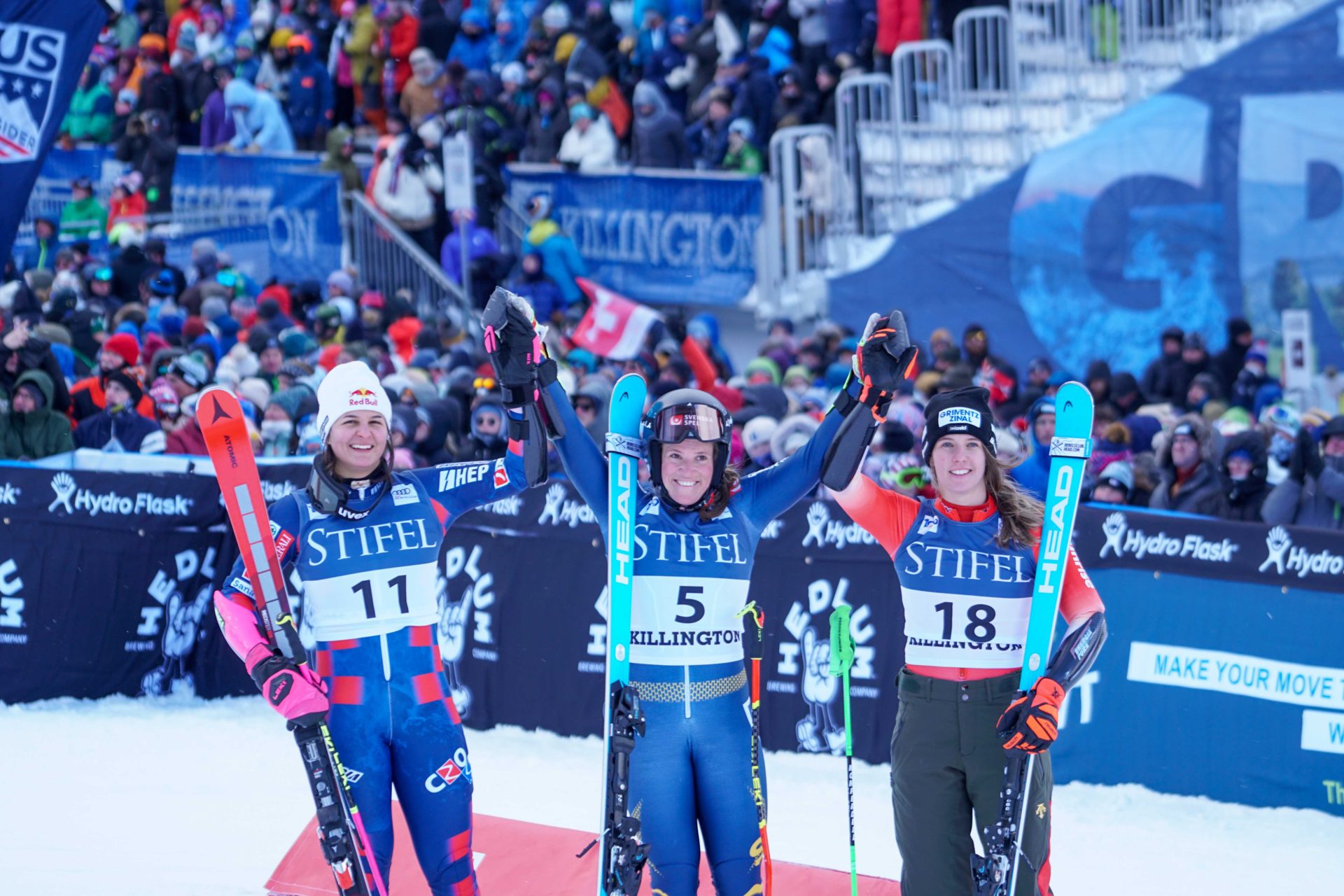
Meanwhile, an injured Shiffrin lay in the netting with coaches and ski patrol assisting her. She would come down in a sled almost 20 minutes later, wave to the crowd, and head to Rutland Regional Medical Center for care. There is no timetable yet for Shiffrin’s return to racing.
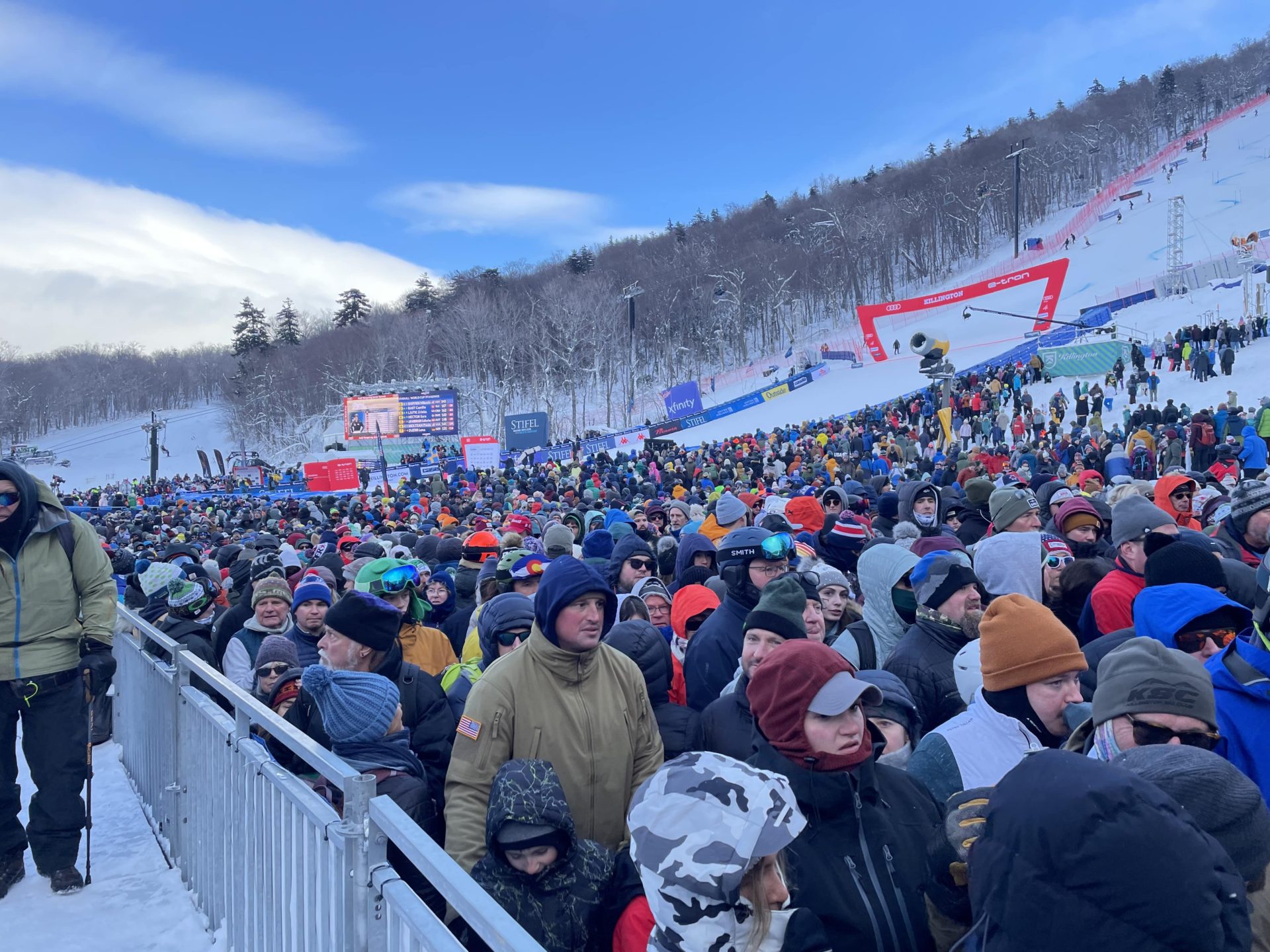
Americans Paula Moltzan and Nina O’Brien finished fifth and sixth, respectively, with Katie Hensien coming in 13th. She had a taste of what it takes to compete with the best skiers in the world and she will probably be back. This current group of American Giant Slalom racers has depth, and it will be interesting to see what they can achieve this season. With so many great skiers to watch, the following racers are worth highlighting: Lara Colturi of Albania, who skied from 19th to 9th; Clarisse Breche of France, who skied from 62nd to 16th; and Gioria Collomb of Italy, who skied from 54th to 19th.

The Sunday crowd, boisterous as usual, was smaller than Saturday’s. The day dawned with slightly better weather and visibility. The hill was still in great race shape and the Slalom skiers were ready to tackle one of the more demanding tracks on the World Cup. It would seem that this would be Camille Rast’s day and weekend (she may want to get a condo in the new Killington village). She won her first World Cup race here and celebrated afterward by doing a cannonball into the pool at the Grand Hotel in her race suit. In what is becoming a unique Killington tradition, Wendy Holdener of Switzerland and Anna Swenn Larsson of Sweden tied for second place rounding out the podium. The pair tied to win the race in 2022. Croatian Zrinka Ljutić overcame a rocky first run to move up into sixth place and Swiss skier Melanie Meillard skied into fifth place. Once again, Clarisse Breche of France skied from a late starting position, 54th, into the top 30, finishing 26th. Paula Moltzan did not finish her run, crashing out and dislocating her shoulder. She is recovering and expects to be racing again soon.
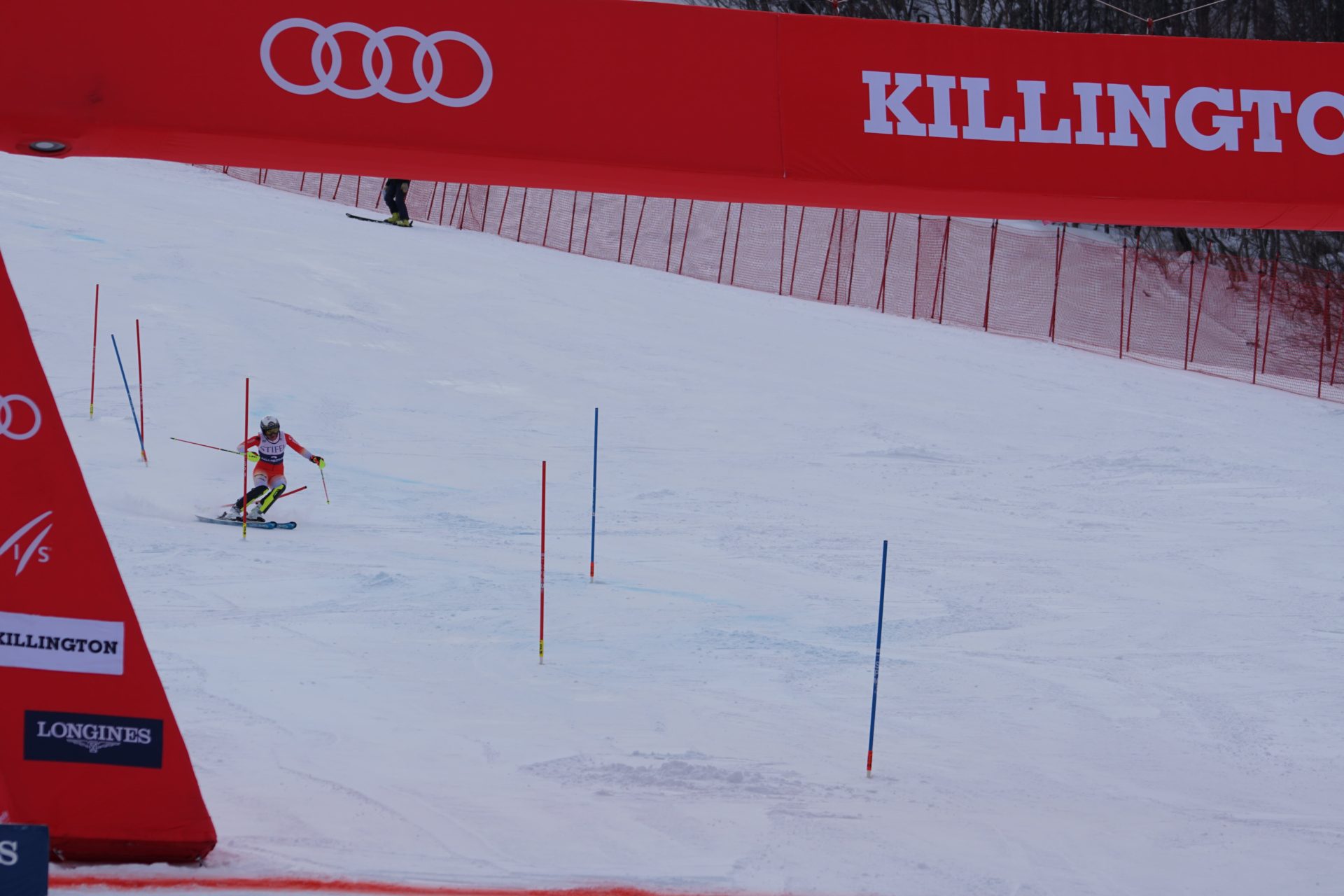
Then the racing was over. The White Circus packed its bags and left Killington. With the races canceled at Mt. Tremblant, some teams athletes stayed and trained on the Superstar from Monday through Wednesday. They too packed their bags and left this corner of the race world to continue to pursue those elusive podiums and wins. In an interview before the World Cup, SnowBrains asked Mike Solimano, if there was a way to quantify the impact of having a World Cup race on the resort. He said, “We did not know it would be as big as it became. As far as return on investment, all events have this challenge. There is no mathematical exercise to prove it’s a good deal. The costs are substantially more than the revenues. Not even close. You have to do it for other reasons. We wanted to support racing on the East Coast. It’s been amazing for the brand.” Hosting the World Cup gives Killington a chance to flex its snowmaking muscle and show the ski world what “world-class” means. Having the FIS excited to race at the venue is also another feather in the Resort’s cap. This certainly helps to reinforce their image as the “Beast of the East.”
At Sunday’s Press Conference, Phil Gross, U.S. Ski Team Trustee and a member of the new Killington Ownership group, said the resort wants the race back. The FIS and the athletes love the venue. The racers enjoy the unique culture of an American ski race where everyone cheers for the racers. They see firsthand how important racing is to this region. Three of the Americans entered in the race spent time racing in Vermont on their path to the World Cup. The impending replacement of the Superstar chairlift at the end of this season looms over the future of the race for next year and possibly beyond. Solimano says that they will know the timeline for the project in early 2026 and then turn their attention to the future of the race. On Saturday, a week after the Giant Slalom and another meticulous grooming process by the snowcat operators, the Superstar reopened to the public; fresh snow is falling in Vermont and skiers are back on the slopes. The White Circus, figurative language used to describe World Cup races that signifies a winter carnival, moves on with East Coast racing fans hoping it will continue to return to Killington for many years to come.
